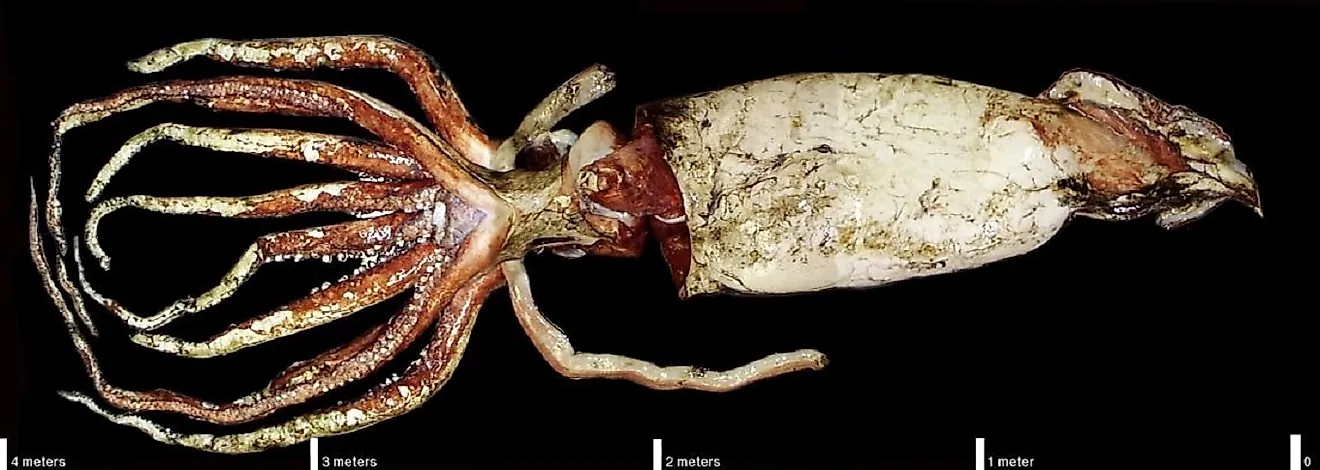Giant Squids - Sea Monsters In Real Life

5. Physical Description
The giant squids (genus: Architeuthis) are gigantic invertebrates of the deep seas of the world whose life cycle and behavior is shrouded in a great deal of mystery due to their elusive nature. The first photograph of a living giant squid was captured in 2004 and the first filming of the creature in its natural habitat was conducted on July, 2012. The giant squids, as the name suggests, have enormous sizes with females attaining a maximum size of about 43 feet and males having a size of 33 feet. One of the largest giant squids discovered so far was 59 feet long and weighed 900 kilograms. The giant squids propel themselves in the water by pulling water into their mantle cavity and releasing it through the siphon. They posses tentacles, divided into carpus, manus, and dactylus, with a large number of suckers on the ventral surface to grapple their prey. A pair of gills allows the creatures to breathe in the ocean. The squids escape their predators by squirting blue ink like substance that reduces the visibility in the waters, allowing the squid time to escape.
4. Diet
Giant squids are predatory in nature and hunt alone in the deep sea for fish and other species of squids. They use their massive tentacles to grasp the prey and immobilizes the prey by means of the sucker rings at the edges of the tentacles. The squid then tears open the prey with its radula and then engulfs it. The squids are in turn, themselves the prey for sperm whales and occasionally, the pilot whales. Thus, these marine invertebrates form an integral part of the ocean food chain.
3. Habitat and Range
The giant squids are quite widespread, found in almost all of the oceans of the world, though in some parts of the oceans they are more frequent than in others. The squids prefer to live in the ocean depths of about 300 to 1,000 meters near the slopes of the continental shelves and the islands. In the North Atlantic Ocean, the giant squids are common in the waters off the coasts of Newfoundland, Spain, British Isles, and Norway, while in the South Atlantic Ocean the squids thrive in the offshore waters of southern Africa. The seas around Japan in the North Pacific and those around New Zealand and Australia are also favored homes of these gigantic creatures. The giant squids thus preferably inhabit the sub-polar, temperate and sub-tropical marine waters and tend to avoid the polar and tropical seas.
2. Behavior

Legends about a sea monster known as the kraken have been prevalent for a long time. Frequent tales have been told where fishermen have described the kraken to drag men from their boats into the ocean depths for feeding on them. Though the kraken appears to fit the description of the giant squids that we know about today, these creatures appear to be quite harmless to humans, with no proven ability to harm boats or humans at sea. The giant squids are extremely elusive sea creatures. They swim around in the ocean’s depths as solitary creatures and only pair up during mating. Very few people have been lucky enough to catch a glimpse of these creatures alive in their natural habitat. Thus, most of what we know today have been derived from remains of these squids washed up on shores, anecdotal reports of giant squid sightings and remnants of these squids in the stomachs of dead sperm whales.
1. Reproduction and Life Cylce
There is very little information available about mating and reproductive behavior of the giant squids. Most of the knowledge has been derived by studying the anatomy of the reproductive parts of dead squids. The females possess a median ovary that produces a large number of eggs with each egg having a tiny size. The females are believed to attain maturity at the age of 3 years. Very little is known about the gestation period or size and number of newborn squids. However, it is believed that the hatchlings grow at an extremely fast rate after birth to attain their giant size. It is estimated that the average life span of giant squids is about 5 years.











